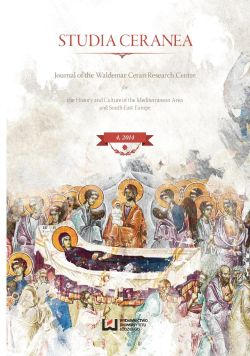Сведения о дуалистических ересях и языческих верованиях в Шестодневе Иоанна Экзарха
Information on dualist heresies and pagan beliefs in John Exarch’s Hexameron (Šestodnev)
Author(s): Georgi Minczew , Małgorzata SkowronekContributor(s): Ivan N. Petrov (Translator)
Subject(s): Cultural history, Bulgarian Literature, Other Language Literature, 6th to 12th Centuries
Published by: Wydawnictwo Uniwersytetu Łódzkiego
Keywords: Medieval dualist heresies; Old Church Slavonic literature; Hexameron; Bulgarian medieval heresies
Summary/Abstract: The article aims to present and analyze those passages of the Hexameron (Šestodnev) in which ‘heretics’, ‘Manichaeans’, ‘pagans’ or ‘pagan Slavs’ are mentioned. The fragments are compared with their Greek counterparts (as long as these exist); the Old Bulgarian texts (especially those that can be considered original additions or loose compilations) are utilized for interpreting certain elements of heterodox doctrines common to Manichaeism, Paulicianism, Massalianism and Bogomilism. The Old Bulgarian translation/compilation by John Exarch supplies important information on the cosmology, theological doctrine and liturgical life of the Neo-Manichaeans within the Byzantine- Slavic world. The original additions and passages that can be seen as loose translations or compilations testify to the relevance of anti-dualist polemics even in the later periods of the Byzantine-Slavic religious community. The old Gnostic and Manichaean concepts, adapted by later dualist heresies (as e.g. Massalianism and Paulicianism), coupled with Trinitarian and Christological deviations from the official dogma, infiltrate the 1st Bulgarian Empire and provide a hospitable environment for the appearance of Bogomilism. In this sense, the Old Bulgarian Hexameron turns out to be an important source of information on the predecessors of the ‘Bulgarian heresy’. The original additions and loose translations/compilations of certain passages uncover some ‘common areas’ characteristic of all medieval Neo-Manichaean doctrines: the dualist creation myth, the belief in Satan as God’s ‘first-born son’ and the related Trinitarian and Christological departures from the prescribed dogma. Especially noteworthy is the passage referring to the Trisagion (Trisvetoe). The rejection of particular elements of the Liturgy of the Faithful attests to the dualists’ more diversified attitude towards the official ritual – not an indiscriminate renunciation, but the exclusion of those elements that were considered to praise the Old Testament God and to be irreconcilable with the Neo-Manichaean beliefs concerning creation and forgiveness. The mentioning of a Slavic pagan sun cult should be analyzed not only in connection with the charges against Manichaeans and Slavs concerning idolatry, but also in a wider context of the refutation of antique astrological beliefs and soothsaying practices. The comparison of particular lexemes, phrases and larger textual units in John Exarch’s Hexameron on the one hand and the Sermon Against the Heretics on the other makes it possible to conjecture that Cosmas the Priest was familiar with his predecessor’s work and made use of it when composing his own anti-heretic text.
- Issue Year: 2014
- Issue No: 4
- Page Range: 95-123
- Page Count: 29
- Language: Russian

